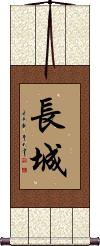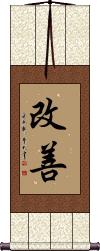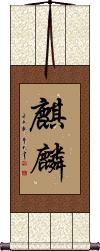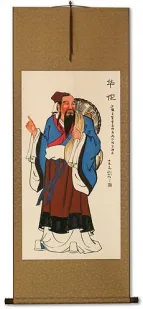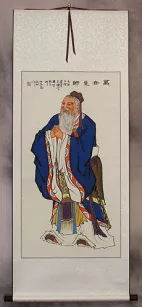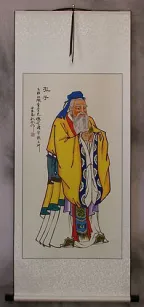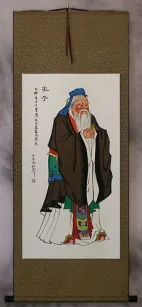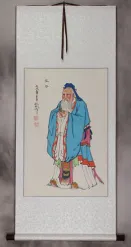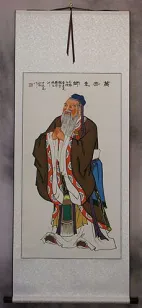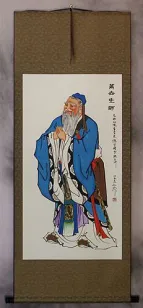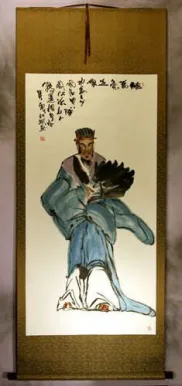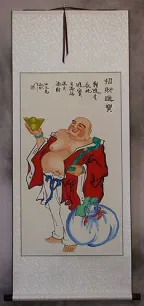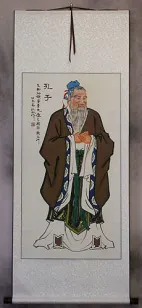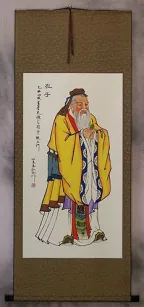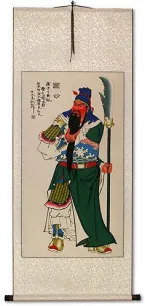Many custom options...
And formats...

Great Wall China in Chinese / Japanese...
Buy a Great Wall China calligraphy wall scroll here!
Personalize your custom “Great Wall China” project by clicking the button next to your favorite “Great Wall China” title below...
The Great Wall of China
The Great Wall of China
長城 is the Chinese name for the Great Wall.
Built at the northern border of China to protect from Mongol attack.
Notes:
In Japanese, this can be a surname Nagaki. Japanese often use a longer title for the Great Wall of China.
In Korean, this refers to Changsŏng (a city in Changsŏng-kun county, Chŏllanam-to province).
Beauty Shop / Beauty Salon
美容店 is how to write “Beauty Shop” or “Beauty Salon.”
If you own such a business, this will make a nice wall scroll to hang up - and many of your Asian customers will be able to read and appreciate it.
When traveling in China, you will see signs like this in the window of any place that offers full services of hair styling, manicures, pedicures, and often shampoo with head and back massage.
However, as a handmade wall scroll, this becomes a very fancy piece of artwork that shows the high class of your business (a great sign for your window if you don't get direct sunlight).
Kai Zen / Kaizen
改善 means betterment, improvement, to make better, or to improve - specifically incremental and continuous improvement.
改善 became very important in post-war Japan when Edwards Deming came to Japan to teach concepts of incremental and continuous improvement (for which the big 3 auto-makers did not want to hear about at the time - even kicking Deming out of their offices). The Japanese workforce absorbed this concept when their culture was in flux and primed for change.
This kaizen term is closely associated with the western title “Total Quality Management.” Perhaps dear to my heart since I spent years studying this at university before I moved to China where TQM did not seem to exist. Slowly, this concept has entered China as well (I've actually given lectures on the subject in Beijing).
If you are trying to improve processes at your business or need to remind yourself of your continuous TQM goals, this would be a great wall scroll to hang behind your desk or in your workplace.
See Also: Kansei
Kirin / Giraffe / Mythical Creature
麒麟 is the title of a mythical beast of Asia.
The animal is thought to be related to the giraffe, and in some ways, it is a giraffe. However, it is often depicted with the horns of a dragon or deer and sometimes with the body like a horse, but many variations exist.
In Japanese, it is pronounced “Kirin” as in “Kirin Ichiban” beer.

Notes:
1. This is sometimes spelled as “kylin.”
2. In Japanese, this is the only Kanji word for giraffe. Therefore in Japan, this word needs context to know whether you are talking about the mythical creature or the long-necked giraffe of Africa.
3. Apparently, this was the first word used for regular giraffes in China (some were brought from Africa to China during the Ming Dynasty - probably around the year 1400). Though the mythical creature may have existed before, the name “qilin” was given to the “new giraffe.” This is because, more than 600 years ago, giraffes somewhat matched the mythical creature's description when Chinese people saw them for the first time. Later, to avoid such an ambiguous title, a three-character word was devised to mean a “giraffe of Africa.” The characters for “qilin” shown here are only for the mythological version in modern Chinese.
4. More information about the qilin / kirin from Wikipedia.
5. This creature is sometimes translated as the “Chinese Unicorn,” although it is generally portrayed with two horns. I think this is done more for the fantasy aspect of the unicorn and because most westerners don't know what a qilin or kirin is (this avoids a long explanation by the translator).
6. In Korean, this can mean kirin or simply giraffe (usually, the mythological creature is what they would think of when seeing these characters alone on a wall scroll).
This in-stock artwork might be what you are looking for, and ships right away...
Gallery Price: $200.00
Your Price: $79.88
Gallery Price: $200.00
Your Price: $79.88
Gallery Price: $71.00
Your Price: $39.00
Not the results for great wall china that you were looking for?
Below are some entries from our dictionary that may match your great wall china search...
| Characters If shown, 2nd row is Simp. Chinese |
Pronunciation Romanization |
Simple Dictionary Definition |
長城 长城 see styles |
cháng chéng chang2 cheng2 ch`ang ch`eng chang cheng choujou / chojo ちょうじょう |
More info & calligraphy: The Great Wall of China(1) long (defensive) wall; (2) (See 万里の長城) Great Wall of China; (surname) Nagaki |
万里の長城 see styles |
banrinochoujou / banrinochojo ばんりのちょうじょう |
More info & calligraphy: The Great Wall of China |
塞内 see styles |
sainai さいない |
(1) inside a fort; (2) (hist) (area) within the Great Wall of China |
塞外 see styles |
sài wài sai4 wai4 sai wai saigai さいがい |
territories beyond the Great Wall (old) (1) outside a fort; (2) (hist) outside the Great Wall of China |
翻牆 翻墙 see styles |
fān qiáng fan1 qiang2 fan ch`iang fan chiang |
lit. to climb over the wall; fig. to breach the Great Firewall of China |
中國長城工業公司 中国长城工业公司 see styles |
zhōng guó cháng chéng gōng yè gōng sī zhong1 guo2 chang2 cheng2 gong1 ye4 gong1 si1 chung kuo ch`ang ch`eng kung yeh kung ssu chung kuo chang cheng kung yeh kung ssu |
China Great Wall Industry Corporation (CGWIC) |
The following table may be helpful for those studying Chinese or Japanese...
| Title | Characters | Romaji (Romanized Japanese) | Various forms of Romanized Chinese | |
| The Great Wall of China | 万里の長城 | ban ri no chou jou banrinochoujou ban ri no cho jo | ||
| The Great Wall of China | 長城 长城 | chou jou / choujou / cho jo | cháng chéng chang2 cheng2 chang cheng changcheng | ch`ang ch`eng changcheng chang cheng |
| Beauty Shop Beauty Salon | 美容店 | měi róng diàn mei3 rong2 dian4 mei rong dian meirongdian | mei jung tien meijungtien |
|
| Kai Zen Kaizen | 改善 | kai zen / kaizen | gǎi shàn / gai3 shan4 / gai shan / gaishan | kai shan / kaishan |
| Kirin Giraffe Mythical Creature | 麒麟 | kirin | qí lǐn / qi2 lin3 / qi lin / qilin | ch`i lin / chilin / chi lin |
| In some entries above you will see that characters have different versions above and below a line. In these cases, the characters above the line are Traditional Chinese, while the ones below are Simplified Chinese. | ||||
Successful Chinese Character and Japanese Kanji calligraphy searches within the last few hours...

